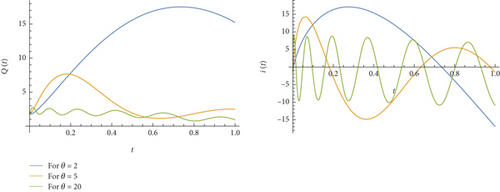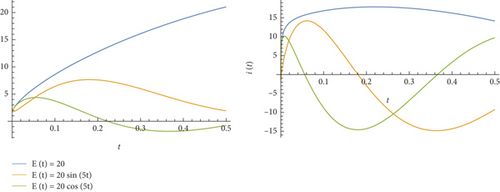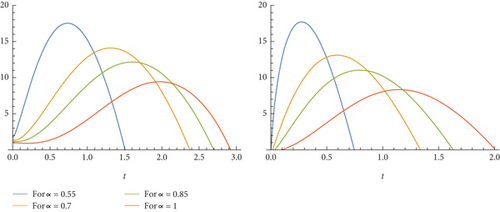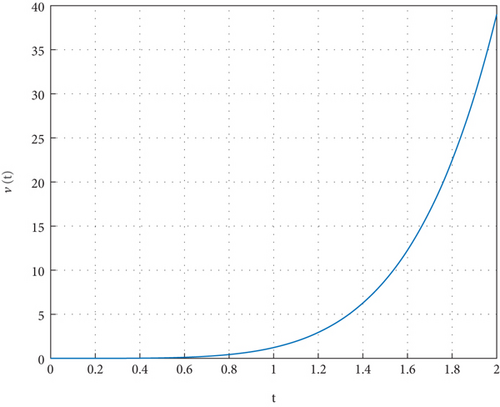The Sequential Conformable Langevin-Type Differential Equations and Their Applications to the RLC Electric Circuit Problems
Abstract
In this paper, the sequential conformable Langevin-type differential equation is studied. A representation of a solution consisting of the newly defined conformable bivariate Mittag-Leffler function to its nonhomogeneous and linear version is obtained via the conformable Laplace transforms’ technique. Also, existence and uniqueness of a global solution to its nonlinear version are obtained. The existence and uniqueness of solutions are shown with respect to the weighted norm defined in compliance with (conformable) exponential function. The concept of the Ulam–Hyers stability of solutions is debated based on the fixed-point approach. The LRC electrical circuits are presented as an application to the described system. Simulated and numerical instances are offered to instantiate our abstract findings.
1. Introduction
Although fractional calculus which can be seen as an extension of traditional calculus is as old as classical calculus, it has become the center of attention in the last decades because fractional differential equations consisting of fractional derivatives which are the most significant subject of fractional calculus express the real-world problem more appropriately in the most of fields such as diffusion [1], engineering [2], tuberculosis (TB) models [3], physics [4], and mathematical physics [5]. Many researchers such as Riemann and Caputo have tried to define what fractional derivatives are since the foundation of the fractional derivative was laid in 1695. In these definitions, there are some drawbacks; for example, some of them do not guarantee that the fractional derivatives of a constant are equal to zero and almost all of them do not fulfill the well-known chain rule, as in the integer order derivatives. In 2014, the conformable derivative given in [6], which is a novel definition and fulfills most of the mentioned above setbacks, was launched. In fact, this new definition is an extension of the traditional derivative of a function. We have observed that fractional derivative becomes an important part of scientific world and is mainly used in the field of health such as the growth of COVID-19 [7, 8], power-law modeling of coronavirus [9], modeling coronavirus disease [10], the Ebola epidemic disease [11], the hantavirus of the European moles [12], and in some mathematical models [13–17]. For more information about conformable derivatives, we advise the readers to look at the works [18–20] and the references therein.
The FLE introduces a fractional derivative in time to model the memory effects in the system. The fractional derivative is usually described using the Riemann–Liouville fractional derivative or the Caputo fractional derivative. The study of fractional Langevin dynamics is relevant in various fields, including physics, biology, and finance, where systems with long-range memory and non-Markovian behavior are observed. Analytical solutions for the FLE are challenging to obtain, and numerical methods are often employed for simulations and analysis. Key applications of FLEs include the following: biological systems: modeling subdiffusion and superdiffusion in biological systems, such as cell movement, protein dynamics, and other intracellular processes; financial markets: describing the behavior of financial assets with long-range dependencies and memory effects; polymer physics: capturing the anomalous diffusion behavior of polymer chains in complex environments; geophysics: modeling the transport of contaminants in heterogeneous geological formations; and material science: understanding the diffusion of particles in disordered materials.
Many researchers make efforts to generalize the classical Langevin equations; for example, fractional Langevin-type equations are the production of these efforts. Even that is enough to show that the traditional Langevin equations fall short or remain incapable of describing some of today’s sophisticated problems in complicated fluctuating media. Recent works have provided more precise representations of existence and uniqueness results for both initial value problems (IVPs) and boundary value problems associated with nonlinear FLEs. Baghani and Nieto [21] demonstrated the existence and uniqueness of solutions through the application of Banach’s contractive mapping principle, while Yu, Deng, and Luo [22] explored the same aspects using Leray–Schauder’s alternative to derive analytical solutions for nonlinear FLEs. Additionally, Yu, Deng, and Luo [22] introduced sufficient conditions for a unique solution using Banach’s fixed-point theorem. Baghani [23] specifically addressed the existence and uniqueness of analytical solutions for the IVP in Langevin-type differential equations. Wei, Li, and Chea [24] tackled the existence and uniqueness problem for the IVP of fractional differential equations involving Riemann–Liouville-type fractional sequential derivatives, employing an iteration technique. In [25], the authors established sufficient criteria for the existence of solutions for nonlinear Langevin equation involving conformable operators of different orders and equipped with integral boundary conditions. Wei, Li, and Chea [24] investigated the theorem regarding the existence and uniqueness of solutions and explored the practical application of Langevin differential equations with fractional orders in various intriguing scenarios, particularly focusing on their relevance to electrical circuits. Some studies have been done on the nonlinear fractional Langevin-type equations which were introduced and researched in many aspects such as existence and uniqueness [26, 27], solutions [28], interpretation of the fractional oscillator process [29], solvability [30], and stability [31]. To the best of our knowledge, there is no study on IVPs governed by the nonlinear sequential conformable Langevin-type differential equations (SCFLDEs).
Our efforts are aimed at obtaining a representation of solutions to inhomogeneous linear sequential conformable equations of the Langevin type. This is achieved through the use of the consistent conformable Laplace transform, which is recognized as a highly efficient and powerful tool for solving various differential systems. In addition, having a formula for representing the solution of a linear sequential conformable equation, we study the qualitative properties of nonlinear sequential conformable equations of Langevin type, such as uniqueness, existence, and stability.
- •
We introduce a novel two-dimensional conformable Mittag-Leffler function.
- •
A representation of the linear system associated with the nonlinear system is provided.
- •
The existence and uniqueness of a solution to our system are investigated, with a focus on its stability.
- •
LRC circuits are reformulated as an application to tailor our system.
This paper is organized as follows. We give a short brief about fractional derivatives and Langevin equations and describe our system in Section 1. We share necessary and available tools and concepts in the literature in Section 2. We introduce the conformable bivariate Mittag-Leffler function and look for a representation of a solution to our system in Section 3. We debate about the existence and uniqueness of a solution to our system and its stability in Section 4. We reformulate the LRC circuits as an application to adapt our system in Section 5. We offer numerical and simulated examples to verify our results in Section 6. We summarize all we discover and express some of the open problems in Section 7.
2. Preliminaries
In this section, we remind necessary tools to enable the readers to understand the coming proofs and statements more clearly.
Definition 1 (see [6].)The following fractional expression
Lemma 1 (see [18].)The conformable derivative of order 0 < α ≤ 1 of a function f : [0, ∞)⟶ℝ exists if it is differentiable at x, and also, holds.
Definition 2 (see [6].)The conformable derivative of order 0 < α ≤ 1 with the lower bound of a function f : [0, ∞)⟶ℝ is given by
Definition 3 (see [20].)The conformable derivative of order n < α ≤ n + 1 with the lower bound of a function f : [0, ∞)⟶ℝ is given by
Proposition 1 (see [20].)Assume that f : [0, ∞)⟶ℝ and 0 < α, β ≤ 1 such that 1 < α + β ≤ 2. Then,
We give a special case of Proposition 1 in the following corollary.
Corollary 1. Assume that f : [0, ∞)⟶ℝ and 1 < 2α ≤ 2. Then,
Lemma 2 (see [20].)Assume that f : [0, ∞)⟶ℝ and α ∈ (0, 1]. Then, we have
Definition 4 (see [20].)For every t ≥ 0, the exponential function in the conformable sense is defined as follows:
Definition 5 (see [32].)If a function f satisfies ‖f(t)‖ ≤ MEα(d, t) for all sufficiently large t, where 0 < α ≤ 1, M and d are positive real numbers; then, f is exponentially bounded in the conformable sense.
Definition 6 (see [32].)The Laplace integral transform of order 0 < α ≤ 1 starting from zero of f in the conformable sense is defined as follows:
Theorem 1 (see [33].)Let f(t) be piecewise continuous on t ≥ 0 and have a conformable exponential order at infinity with |f(t)| ≤ ME(a, t) for t ≥ C. Then, the conformable Laplace transform exists for s > a.
Theorem 2 (see [34].)Suppose f(t), , ,…, are continuous and is piecewise continuous on any interval [0, T]. Assume further that f(t), ,…, have a conformable exponential order at infinity. Then, exists and
Theorem 3 (see [35].)Assume that f, g : [0, ∞)⟶ℝ and 0 < α ≤ 1. The convolution in the conformable sense of f and g is defined by
Proposition 2 (see [36].)The gamma function Γα(β) in the conformable sense holds the following identities:
- 1.
Γα(β + 1) = (β + α − 1)Γα(β)
- 2.
Γα(β) = α(β + α − 1)/αΓ((β + α − 1)/α)
- 3.
Γα(1) = α
Theorem 4 (see [36].)For p > 0, 0 < α ≤ 1, the conformable Laplace transforms of 1, t, and tp are equal to
- 1.
- 2.
- 3.
Theorem 5 (see [20].)Let r be both nonnegative and continuous on an interval [a, b] and σ and d be nonnegative constants such that
Then, for all t ∈ [a, b],
Definition 7. The system (1) is said to be Ulam–Hyers stable if for every ε > 0 and every solution y ∈ C([0, T], ℝ) of inequality,
Then, there exists a solution ν ∈ C([0, T], ℝ) of the system (1) and a real number ς > 0 such that
Remark 1. A function y ∈ C1([0, T], ℝn) is a solution of the inequality Equation (6) if and only if there exists a function ρ ∈ C([0, T], ℝn) for every ε > 0, such that
- •
‖ρ(t)‖ < ε
- •
From Section 3 on, we share our novel contributions.
3. A Representation of Solutions of the Linear System
In this section which is the principle and longest part of the current paper, we spend our efforts to get a representation of solutions to nonhomogeneous linear SCFLDEs via the conformable Laplace integral transformation which is the most useful and powerful tool to solve many differential systems.
So as not to get bogged down in the details of the upcoming proofs, we need to make some preparations by offering lemmas which are valuable all by themselves.
Lemma 3. The following expressions hold true.
Proof 1. We prove the first one by using the binomial series. Based on |λ/s| < 1, one has
In the light of the first item and geometric series with |μ/(s2 − λs)| < 1 and |λ/s| < 1, one gets
Definition 8. The conformable bivariate Mittag-Leffler function Eα,β,γ(u, v): [0, ∞)⟶ℝ is defined as follows:
Lemma 4. We have the following equalities, for λ, μ ∈ ℝ, (1/2) < α ≤ 1, and s > 0,
Proof 2. Under the choices of λ, μ ∈ ℝ, 0 < α ≤ 1, and s > 0, we take the former into consideration
We use Equation (3), Theorem 3, and the former one to show the trueness of the latter one:
The representation of solutions to the system (1) is stated in the sequent theorem.
Theorem 6. Assume that the conformable Laplace transform of , , ν(t), and f(t) exists. The following
Proof 3. Applying the conformable Laplace integral transformation to the system (1), we get
Implementing Equations (4) and (5) to the above equation, we get
We employ common factor brackets to rearrange the upper equation
Taking the conformable Laplace inverse transform on both sides in the below equation with the help of Equation (3), we acquire
With the aid of Lemma 4, the desired result can be obtained as follows:
Lemma 5. The following expression holds true.
Proof 4. Using the substitution u = (tα/α) − (sα/α), one can get
Lemma 6. The conformable Langevin differential Equation (1) is equivalent to the following integral equation:
Proof 5. Applying the conformable integral to the Langevin differential Equation (1) twice via Lemma 2, one can easily get
Again repeat the same action for the just-above equality, one can get
Corollary 1 provides what we want as the following equality:
Theorem 7. Suppose that Equation (1) has a unique continuous solution ν(t) on [0, T]. If f and for 0 < α ≤ 1 are conformable exponentially bounded on [0, T], then the conformable Laplace transformations of ν(t) and for 1 < 2α ≤ 2 exist.
Proof 6. Lemma 6 expresses that each solution of Equation (1) is also a solution of Equation (8) and vice versa. We simplify Equation (8) as noted below.
Due to the fact that f(t) is conformable exponentially bounded, we have
Setting
For t ≥ K, we have
When inequalities (10) are used in the just-above inequality, one can get
We multiply both sides of the inequality by Eα(−δ, t) and use the inequalities Eα(−δ, t) ≤ Eα(−δ, K) for t ≥ K and Eα(−δ, t) ≤ Eα(−δ, s) for t ≥ s to acquire
Due to Equation (9) and Lemma 5, we easily get
If we denote
This means that ν is conformable exponentially bounded on [0, T]. Since f and for 0 < α ≤ 1 are also conformable exponentially bounded on [0, T] from the statement of the theorem, for 1 < 2α ≤ 2 is also conformable exponentially bounded on [0, T] because it is a linear combination of expressions that are conformable exponentially bounded. This is the desired result.
4. Existence and Uniqueness Results and System Stability
In the current section, we first discuss whether a solution to the nonlinear sequential conformable Langevin-type differential system (1) is unique in addition to whether it exists. In the sequel, we debate the concept of stability analysis in terms of solutions to the system (1) based on the fixed-point approach.
Theorem 8. The estimation which is given below always holds true.
d is -1 or 0, α > 0, and μ, λ, and t are real numbers.
Proof 7. Under the restrictions on the parameter, we get
By using the relationship between the conformable gamma function and the well-known gamma function, one gets
If one combines these facts, the below inequality is acquired:
If we replace t with tα/α, we get the estimation expressed in the following corollary.
Corollary 2. Let α > 0 and let μ, λ, and t be real numbers.
Theorem 9. Assume that f : [0, T] × ℝ⟶ℝ is so continuous that it satisfies the Lipschitz condition with the Lipschitz constant Lf, that is,
The nonlinear sequential conformable Langevin system (1) has a unique solution on C2([0, T], ℝ).
Proof 8. As a norm on C2([0, T], ℝ), we define the following function:
Since the well-known space (C2([0, T], ℝ), ‖.‖∞) is complete with respect to ‖.‖∞ and ‖.‖∞ and ‖.‖w are equivalent, C2([0, T], ℝ) is complete with respect to ‖.‖w. Now, we define
One can rewrite the above equation as follows with the help of Theorem 3:
Consider the following expression for ν, u ∈ ℝ,
By exploiting Corollary 2, Lemma 5, and the Lipschitz property of f, one gets
It is possible to choose sufficiently large w > 0 such that
This means that is a contraction. By Banach’s fixed-point theorem, has a unique fixed point. Based on this, one understands that a representation of solutions to the system (1) is both existent and unique on C2([0, T], ℝ).
Theorem 10. Assume that f is a Lipschitzian function with respect to the second component. Then, the system (1) is stable in the Ulam–Hyers sense.
Proof 9. Let η ∈ C2([0, T], ℝ) that fulfills the inequality (6), and let u ∈ C2([0, T], ℝ) that is the unique solution of the system (1) with u0 = η0, u1 = η1. By employing the rule of and Remark 1, one can have
Now, everything is ready to estimate |u(t) − η(t)|:
From the just-above inequality, one can easily get the desired result:
5. An Application to the LRC Circuits
In the present section, we share an LRC electrical circuit that has widespread applications such as the tuning process of television sets, radio receivers, communication systems, and signal processing, to exemplify our theoretical findings, especially offered by Theorem 6.
Second-order nonhomogeneous linear ordinary differential equations arise in the study of electrical circuits after the application of Kirchhoff’s law [37, 38].
Our goal is to model this LRC electrical circuit with an IVP so that we can determine the current and charge in the circuit.
For convenience, the units of inductance (L), resistance (R), capacitance (C), charge (Q), and current (I) as electrical quantities are henry (H), ohm (Ω), farad (F), coulomb (C), and ampere (A).
For all simulations, we select the common parameters α = 0.55, L = 10, R = 20, C = 1/15, Q0 = 1, and Q1 = 0.6. The graphs of the charge Q and current I for E(t) = 20 together with the common parameters are placed in Figure 1. The charges Q and currents I for distinct frequencies θ = 2, 5, 20 in E(t) = 20sin(θt) are plotted in Figure 2. For E(t) = 20, E(t) = 20sin(2t), and E(t) = 20cos(2t), the charges Q and currents I are drawn in Figure 3.
Remark 2. As shown in Figure 2, the wavelengths of the currents decrease as frequency values increase. It can be read from Figure 3 that E(t) and I(t) are of similar characteristic properties, their amplitudes may be different, and there may also be a phase shift in charge differences.
Remark 3. Under the choices of L = 10, R = 20, C = 1/15, Q0 = 1, Q1 = 0, 6, and E(t) = 20sin(2t), the charges Q and currents I corresponding to each of α = 0.55, α = 0.7, α = 0.85, and α = 1 are drawn in Figure 4. It is observed that the maximum current values of the system decrease while α values in the system increase.




6. Examples
In this section, we exemplify Theorems 6, 9, and 10.
Example 1. We consider the following linear SCFLDEs:
It is clear that the system (14) becomes the system (1) with its parameters assigned by certain values. Based on Theorem 6, one gets an explicit solution in a closed form to the system (14) as noted below:
Example 2. We consider the following nonlinear SCFLDEs:
It is clear that the system (15) becomes the system (1) with its parameters assigned by certain values. Based on Theorem 6, one gets the global solution in a closed form to the system (15) as noted below:
One can easily show that the disturbance function f(t) = tan−1(ν(t))/(2 + t6) is a Lipschitzian function with respect to the second component as shown below

7. Conclusion
We introduce the SCFLDE. With the help of the conformable bivariate Mittag-Leffler function, an exact analytical solution to linear SCFLDE is obtained through the conformable Laplace transforms. A representation of it is extended to a global solution to the nonlinear SCFLDE. In the sequel, we show that the nonlinear SCFLDE which is stable has a unique solution. We give a detailed application of the LRC circuits and simulated and numerical instances to instantiate our abstract findings. The coming research could be devoted to the notions of asymptotic stability, finite time stability, exponential stability, and Lyapunov-type stability. Another possible study is to ask whether it is approximately controllable or controllable through iterative learning. As another possible study, the system in the case of the general fractional orders may be reconsidered. One can investigate all mentioned above things about the SCFLDE with variable coefficients obtained by replacing constant coefficients with variable coefficients.
Conflicts of Interest
The authors declare no conflicts of interest.
Author Contributions
N. I. Mahmudov carried out the concept and design of the article and helped to draft the manuscript. M. Aydin performed analysis and interpretation of data for this paper, conceived the study, participated in its design and coordination, and drafted the manuscript. All authors read and approved the final manuscript.
Funding
The authors received no specific funding for this work.
Open Research
Data Availability Statement
No underlying data was collected or produced in this study.




